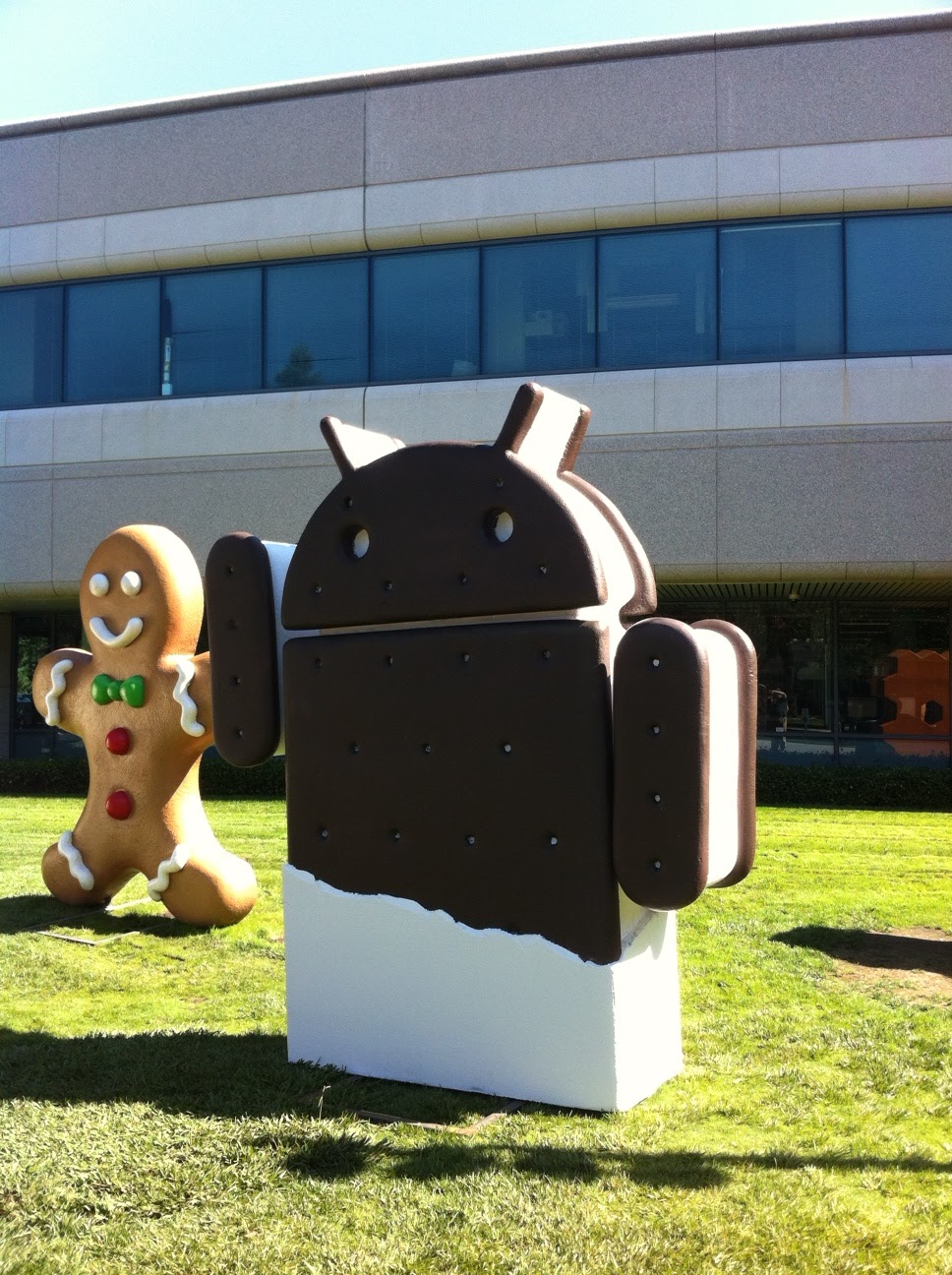Inside the different Android versions
Each major version of Android has a
dessert-based nickname, and they are all in alphabetical order. We like to
think it's because of the delicious things they each have offered, but the
folks at Google are pretty tight-lipped about why they used the internal code
names they did. They certainly have a good sense of humour, and seem to like
tasty deserts.
This is your quick primer on the different
versions of Android that are still alive and kicking, from newest to oldest.
Android
7 Nougat (2016)
In March this year, Google surprised pretty
much everyone by releasing the N Developer Preview a full month and a half
ahead of the yearly Google I/O developer conference. This gives app developers
(and hard-core nerds) the opportunity to taste the next major flavour of
Android before it's actually released. On June 30, Google gave us the nickname:
Nougat.
New in this iteration — so far
— is the long-awaited native support for multi-window, so apps can live
side by side. Google's also adding in direct-reply notifications and bundled
notifications. That's just the start, of course. There will be more additions
as we get closer to release.
Google also is giving developers (and, yes,
civilians) the opportunity to get in on the preview action with over-the-air
updates for the first time. So if you don't know how to update manually by
flashing factory images, you're not left out in the cold.
Things are broken. Things are unfinished.
But it's also very, very cool.
Android
6.0 Marshmallow (late 2015)

Google released Android 6.0
Marshmallow with the Nexus 6P and the Nexus 5X. Along with
some visual changes — like a new launcher and refined notification panel — we
saw a couple under the hood changes and new features (as always).
Android 6.0 gave us better control over
permissions, allowing you to control what parts of your data apps can access,
rather than approve it by simply installing the app in the first place. That's
just the beginning, and features like app linking and the new Assist API allow
developers to build better and more powerful apps. We all love better and more
powerful apps.
Google also implemented a developer preview
program for Marshmallow, allowing folks with a supported Nexus phone or tablet
to give things an early try.
Android
5.0 Lollipop (late 2014)
Google released Android 5.0 Lollipop with
the Nexus 6 and Nexus 9, and it ushered in a new design language
and support for 64-bit devices. It's also the first time Google has provided
developer beta previews of the software, so that the apps we all love can be
ready when the new version drops.
There were big changes under the hood as
well, and a plethora of new API changes in addition to forward-facing features
like a new interface. Google has updated its own Nexus 5, Nexus 4 and Nexus 7
to Lollipop, and other companies like Motorola, Samsung, HTC and LG have been
relatively quick to follow.
But the Lollipop update hasn't sat well
with many folks out there, and even Google was plagued by performance issues
both with the update and with the initial releases of Lollipop.
Android
4.4 KitKat (late 2013)
Google in September 2013 announced that the
new version of Android would be named for their favourite
confectioneries — Kit Kat bars. A couple months later we saw its
release with the LG Nexus 5.
KitKat brought a lighter, flatter and far
more colourful look to Android, but many more changes were under the hood.
These were the foundation for things like the Google Now launcher, SMS integration
with Hangouts, and easier and faster use all around.
Android
4.1-4.3 Jelly Bean (mid-2012)
Jelly Bean arrived at Google IO 2012 with
the release of the ASUS Nexus 7, followed by a quick update for unlocked Galaxy
Nexus phones. Later in the year, the release of the Nexus 10 and Nexus
4 updated things from 4.1 to 4.2 and on to 4.3, but the version remained
Jelly Bean. The release polished the UI design started in Ice Cream
Sandwich, and brought several great new features to the table.
Besides the new focus on responsiveness
with Project Butter, Jelly Bean brings multi-user accounts, actionable notifications,
lock screen widgets, quick-settings in the notification bar, Photosphere to the
"stock" Android camera and Google Now.
Jelly Bean is hailed by many as the turning
point for Android, where all the great services and customization options
finally meet great design guidelines. It's certainly was very visually
pleasing, and we'd argue that it was one of the nicest looking mobile operating
systems available at the time.
Android
4.0 Ice Cream Sandwich (late 2011)

The follow-up to Honeycomb was announced at Google
IO in May 2011 and released in December 2011. Dubbed Ice Cream
Sandwich and finally designated Android 4.0, ICS brought many of the
design elements of Honeycomb to smartphones, while refining the Honeycomb
experience.
The first device to launch with ICS was the Samsung
Galaxy Nexus. The Motorola Xoom and the ASUS Transformer Prime were the first
tablets to receive updates, while the Samsung Nexus S was the first smartphone
to make the jump to Android 4.0.
Android
3.x Honeycomb (early 2011)
Android 3.0 Honeycomb came out in
February 2011 with the Motorola Xoom. It's the first (and only) version of
Android specifically made for tablets, and it brought a lot of new UI elements
to the table. Things like a new System bar at the bottom of the screen to
replace the Status bar we see on phones, and a new recent applications button
are a great addition for the screen real estate offered by Android tablets.
Some of the standard Google applications
have also were updated for use with Honeycomb, including the Gmail app and the
Talk app. Both made great use of fragments, and the Talk app added
video chat and calling support built in. Under the hood, 3D rendering and hardware
acceleration have been greatly improved.
Improvements to Honeycomb were announced at
Google IO in May 2011 as Android 3.1, and Android 3.2 followed thereafter.
But Honeycomb basically is regarded as a forgotten version.
Android
2.3 Gingerbread (late 2010)
Android 2.3 Gingerbread came out
of the oven in December 2010, and like Eclair had a new "Google phone"
to go along with — the Nexus S. Gingerbread brings a few
UI enhancements to Android, things like a more consistent feel across
menus and dialogs, and a new black notification bar, but still looks and feels
like the Android we're used to, with the addition of a slew of new
language support.
Gingerbread brings support for new
technology as well. NFC (Near Field Communication) is now
supported, and SIP (Internet calling) support is now native on Android. Further
optimizations for better battery life round out a nice upgrade.
Android
2.2 Froyo (mid-2010)

Android 2.2 Froyo was announced in
May 2010 at the Google IO conference in San Francisco. The single
largest change was the introduction of the Just-In-Time Compiler — or JIT —
which significantly speeds up the phone's processing power.
Along with the JIT, Android 2.2 also brings support
for Adobe Flash 10.1. That means you can play your favourite Flash-based games
in Android's web browser.
Froyo also brought native support for
tethering, meaning you could use your Android smartphone's data connection to
provide Internet (wirelessly or with a USB cable) to just about any device you
want. Sadly, most carriers will strip this native support in exchange for some
sort of feature they can charge for. (Can't really blame them, can you?)
Android
2.0-2.1 Eclair (late 2009)

Eclair was a pretty major step up over
its predecessors. Introduced in late 2009, Android 2.0 first appeared on the Motorola
Droid, bringing improvements in the browser, Google Maps, and a new user
interface. Google Maps Navigation also was born in Android 2.0,
quickly bringing the platform on par with other stand-along GPS navigation
systems.
Android 2.0 quickly gave way to 2.0.1,
which the Droid received in December 2009, mainly bringing bug fixes. And to
date, the Droid remains the phone to have explicitly received Android 2.0.1.
The now-defunct Google Nexus One was
the first device to receive Android 2.1 when it launched in January 2010,
bringing a souped-up UI with cool 3D-style graphics. From there, the rollout of
Android 2.1 has been relatively slow and painful.
HTC's Desire and Legend phones launched
with Android 2.1 later in the year, touting a new and improved Sense user
interface.
Android
1.6 Donut (late 2009)
Donut, released in September 2009, expanded
on the features that came with Android 1.5. While not very rich in the
eye-candy department, Android 1.6 made some major improvements behind the
scenes, and provided the framework base for the amazing features to come.
To the end user, the two biggest changes would have to be the improvements to
the Android Market, and universal search.
Behind the screen, Donut brought support
for higher-resolution touchscreens, much improved camera and gallery support,
and perhaps most importantly, native support for Verizon and Sprint phones.
Without the technology in Android 1.6, there would be no Motorola Droid X or
HTC EVO 4G — two major phones for those carriers.
Android
1.5 Cupcake (mid-2009)
Cupcake was the first major overhaul
of the Android OS. The Android 1.5 SDK was released in April 2009
and brought along plenty of UI changes, the biggest probably being support for
widgets and folders on the home screens.
There were plenty of changes behind the
scenes, too. Cupcake brought features like improved Bluetooth support,
camcorder functions, and new upload services like YouTube and Picasa.
Android 1.5 ushered in the era of the
modern Android phone, and the explosion of devices included favourites like the
HTC Hero and Eris, the Samsung Moment, and the Motorola Cliq.
The basic building blocks of Android come
in many flavour’s, with each major release receiving a tasty nickname!
At The Computer Guyz in Cape Town and Centurion, we have a number of different services to offer, from repairs and ADSL bandwidth to graphic design and website hosting or simply some friendly advice.

Nice it seems to be good post... It will get readers engagement on the article since readers engagement plays an vital role in every blog.i am expecting more updated posts from your hands.
ReplyDeleteiOS App Development Company
Here are 6 steps how to complete a project handoff.
ReplyDeleteFirst of all, thanks for all the useful information. I would prefer to thank the stress of the golf shot for connectivity that plays a leading role in hosting. I appreciate your diligence. Keep posting new updates with us.
ReplyDeleteDedicatedHosting4u.com